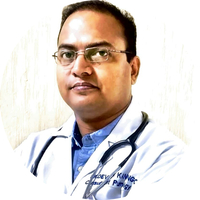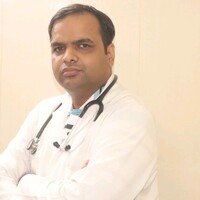Summary
Pneumonectomy is a lung surgery procedure that is done to remove a diseased lung from the body. This surgery is performed when the surgeon finds the unaffected lung (other than the diseased lung) to be healthy enough to perform normal body functions such as taking up enough oxygen and removing carbon dioxide. You will be given general anaesthesia before the start of the surgery so that you do not experience pain during the procedure. You may need to be at the hospital for seven to nine days after the surgery. Your recovery period may extend from a few weeks to months.
- What is pneumonectomy?
- Why is pneumonectomy recommended?
- Who can and cannot get pneumonectomy?
- What preparations are needed before pneumonectomy?
- How is pneumonectomy done?
- How to care for yourself after pneumonectomy?
- What are the possible complications/risks of pneumonectomy?
- When to follow up with your doctor after a pneumonectomy?
What is pneumonectomy?
Pneumonectomy is a surgery that is done to remove a whole lung from the body.
The air taken in through the nose or mouth passes through the windpipe. The windpipe divides into two separate pipes that enter one in each lung. The lungs take up oxygen from the inhaled air, which is utilised for body functions. After taking up oxygen, the lungs remove carbon dioxide from the body.
When one of the lungs is entirely damaged due to conditions such as injury or cancer, pneumonectomy is recommended. In this procedure, the surgeon removes the diseased or affected lung. Each lung has a sac-like structure around it called the pleural sac. After the lung is removed the sac fills up with air. The air is gradually replaced by body fluids. Most individuals can survive with one lung as it can take up enough oxygen and remove carbon dioxide necessary for normal body functions.
Why is pneumonectomy recommended?
This surgery is most commonly performed in individuals with lung cancer that cannot be treated with smaller surgeries. Symptoms of lung cancer include breathlessness that persists for a long time, coughing up blood, loss of appetite and pain while coughing or breathing. Other conditions that may warrant this surgery and their symptoms are as follows:
-
Pulmonary tuberculosis:
- Night-time sweating
- Loss of appetite
- Fatigue (extreme)
- High body temperature
- Bronchiectasis:
- Coughing up green/yellow coloured mucus
- Fatigue
- Chest pain along with breathing difficulty
- Chills and/or fever
- Blockage in the airways and a damaged lung (causing obstruction in the airways of the lungs):
- Bluish colouration of the skin
- Inability to breathe
- Loss of consciousness
- Shallow or rapid breathing
- Traumatic lung injury: In case of an external injury, you may experience the following symptoms:
- Shortness of breath
- Rapid heartbeat
- Chest pain
- Coughing
- Fungal lung infection: The symptoms of a fungal lung infection are:
- Fever
- Difficulty breathing
- Chest pain
- Wheezing
- Lung diseases since birth.
- Cancer in the lungs that has spread from other body organs.
Who can and cannot get pneumonectomy?
The surgery is not recommended if:
- The results of the lung function tests and heart tests deem you unfit for the surgery
- The imaging tests reveal that the lung tumour has extended into your ribs or abdomen
If you have a heart disease or high blood pressure that affects the blood vessels in the lungs, the surgery will be performed with caution.
What preparations are needed before pneumonectomy?
A detailed testing of your lungs and heart will be conducted to ensure that your other lung is healthy and that your heart can withstand the surgery, respectively. Medical and imaging tests performed as part of the pre-operative assessment include:
- Blood tests - to examine your fitness and general health
- Electrocardiogram - to measure the electrical activity of the heart and muscle function
- Chest x-ray - to check the organs in your chest – the heart and lungs
- Lung function tests - to measure the amount of air that your lungs can hold, and understand the working of your lungs
- Spirometry - to determine the amount of air you inhale and the way you inhale and exhale
- Lung perfusion scan - to look at the blood flow in the lungs and measure your ability to inhale
- Ultrasound - to examine the lungs for any fluids
- Computed tomography or magnetic resonance imaging - to examine whether cancer in your lungs has spread to nearby organs
- Positron emission tomography scan - to check for the presence of active cancer cells anywhere in the body
Your surgeon will discuss the preparations required before the surgery as follows:
- You will need to share the list of all the medicines that you take, including vitamins, herbs and supplements.
- The surgeon may ask you to discontinue taking aspirin, anti-inflammatory drugs and blood-thinning drugs a few days before the surgery.
- Your allergies and medical history will be taken.
- You will be advised to stop smoking before your surgery.
- Certain exercises may be recommended in the days leading to the surgery in preparation for the surgery.
- You will be asked to use a spirometer to perform breathing exercises.
- The surgeon will ask you not to drink or eat anything from the night prior to the surgery.
- The hair on your body around the site of operation will be removed before the procedure.
How is pneumonectomy done?
There are two types of pneumonectomy: traditional and extrapleural pneumonectomy. Traditional pneumonectomy usually involves the following steps:
- You will be asked to lie on your side with the arm on the side to be operated on placed over your head.
- The medical staff will insert an intravenous line into your arm, through which medicines and fluids will be given.
- The anesthesiologist will then give you general anaesthesia to make you fall asleep.
- The surgeon will make a long incision between your two ribs over the diseased lung. The incision will extend from under your arm to the back.
- Next, the surgeon will separate your ribs; in some cases, a small portion of the rib will also be removed.
- He/she will clamp the bronchi (the branches of the windpipe supplying air) to the diseased lung and tie off the blood vessels that supply and drain blood to and from the diseased lung. The blood vessels will be moved away from the area of surgery.
- Then, the surgeon will deflate (collapsed) and remove the affected lung.
- He/she will bring your ribs back in their original position, close the muscles and skin over it and cover the incision with a dressing.
Finally, the surgeon will insert a tube into the operated area of your chest. This tube is temporary and will be removed when your condition becomes stable.
In extrapleural pneumonectomy, parts of diaphragm and pericardium and the lining of the chest cavity are also removed along with the lung and will be replaced with a safe, synthetic material.
The surgery can also be performed by a minimally invasive method known as video-assisted thoracoscopic surgery. In this procedure, the surgeon makes several tiny cuts instead of one large cut. Several instruments are inserted through the cuts, including a thoracoscope (a special instrument containing a video camera), to remove the affected lung.
After the surgery, the hospital staff will wheel you to an intensive care unit where an external device will assist you in breathing for the first 24 hours. Once your condition is stable, you will be moved to a regular hospital ward. Individuals who have undergone traditional pneumonectomy need to be in the hospital for seven days, while those who have undergone extrapleural pneumonectomy have to be hospitalised for eight to nine days. You can expect the following after surgery:
- You may be in a state of confusion when you wake up. This is due to the effects of the anaesthesia which will soon wear off.
- A nurse will monitor your vital signs, such as oxygen level, blood pressure, breathing and heart rate are continuously monitored.
- You will be given pain medicines for any pain you may feel at the operated area.
- You will be given oxygen through an oxygen mask and your urine will be drained through a tube (catheter) in your bladder.
- You may also be provided with special stockings to prevent the formation of blood clots in your legs.
- The medical staff will teach you special breathing techniques, which you should do several times a day to keep your airways open.
How to care for yourself after pneumonectomy?
You may require several weeks to months to recover completely. Your activity will also be restricted for one to two months. You should take the following care during the recovery period at home:
- Post-surgery pain: You may be prescribed pain medications for a few days. Take them as directed. As constipation is a side effect of many strong painkillers, the surgeon may also prescribe laxatives.
- Smoking: You should avoid smoking after surgery since it can cause discomfort and irritate your lungs.
- Dietary recommendation: You can follow your normal diet during recovery, although a high-protein diet is recommended to aid in healing.
- Wound care: Shower every day to keep the operated area clean. Moreover, avoid the use of powder or deodorant in the wound area.
- Rest and exercise: You may have to curtail your activities after the surgery as you need plenty of rest as you may feel tired easily. During such periods, take short naps instead of resorting to sleeping on the bed. Walking around is recommended as it can assist you to breathe deeply. Practice breathing exercises regularly.
- Travelling: You need to ask your surgeon about when you can resume driving or travelling by flight.
- Resuming work: The time required to resume work depends on the nature of your work. During one of your follow-up appointments, the surgeon will advise you when you can resume work.
This surgery can help to control the spread of cancer. It can also slow down the progression of the disease and improve breathing and quality of life.
When to See the Doctor?
You should contact the surgeon immediately if you have any of the following after the surgery:
- Fever
- Cough
- Chest pain
- Shortness of breath
- Red or swollen wound
- Pain or blood oozing from the wound at the site of operation
What are the possible complications/risks of pneumonectomy?
Although pneumonectomy is a high-risk surgery, the results turn out to be positive in most individuals. The possible complications associated with the surgery are:
- Blood clot formation in the lung
- Shock
- Wound infection
- Accumulation of fluid in the lungs
- Accumulation of pus in the chest cavity
- Shortness of breath
- Dependence on external breathing devices for extended periods
- Respiratory failure
- Excess bleeding
- Pneumonia
- Irregular heart rhythm
- Decreased blood flow to the heart
- Complications of general anaesthesia such as confusion, drug allergy and heart attack
When to follow up with your doctor after a pneumonectomy?
The surgeon will provide you with dates for follow-up visits. The sutures will be removed in one of your follow-up appointments.
Disclaimer: The above information is provided purely from an educational point of view and is in no way a substitute for medical advice by a qualified doctor.
Surgery Cost In Your City
Doctors for Pneumonectomy

Dr. Devesh Kanoongo
Pulmonology
18 Years of Experience

Dr Viresh Mariholannanavar
Pulmonology
2 Years of Experience

Dr Shubham Mishra
Pulmonology
1 Years of Experience

Dr. Deepak Kumar
Pulmonology
10 Years of Experience
References
- University of Rochester Medical Center [Internet]. Rochester (NY): University of Rochester Medical Center; Pneumonectomy
- Liverpool Heart and Chest Hospital NHS Foundation Trust [Internet]. National Health Service. UK; Lung Surgery
- National Health Service [internet]. UK; Lung Cancer
- American Lung Association [internet]. Chicago. Illinois. US; Bronchiectasis Symptoms and Diagnosis
- American red cross [Internet]. Washington DC. US; Conscious Choking
- Akgul Ozmen C, et al. Radiologic findings of thoracic trauma. Ther Clin Risk Manag. 2017; 13: 1085–1089. PMID: 28894371.
- University of Connecticut [Internet]. Connecticut. US; Pulmonary Contusion
- Ganie Farooq Ahmad, et al. Lung Contusion: A Clinico-Pathological Entity with Unpredictable Clinical Course. Bull Emerg Trauma. 2013 Jan; 1(1): 7–16. PMID: 27162815.
- UCSF health: University of California [internet]. US; Tests for Lung Patients
- Cleveland Clinic. [Internet]. Cleveland. Ohio. US; Aspergillosis
- Beshara M, Bora V. Pneumonectomy. [Updated 2020 Mar 10]. In: StatPearls [Internet]. Treasure Island (FL): StatPearls Publishing; 2020 Jan
- Harvard Health Publishing. Harvard Medical School [internet]: Harvard University; Pneumonectomy
- Oxford University Hospitals [internet]: NHS Foundation Trust. National Health Service. U.K.; Thoracic Surgery Lung Resection
- South East Scotland Cancer Network [Internet]. National Health Service. UK; Lobectomy/Pneumonectomy
- UCSF Department of Surgery [internet]. University of California San Francisco. California. U.S.A.; Extrapleural Pneumonectomy
- Hernandez A, Sherwood ER. Anesthesiology principles, pain management, and conscious sedation. In: Townsend CM Jr, Beauchamp RD, Evers BM, Mattox KL, eds. Sabiston Textbook of Surgery. 20th ed. Philadelphia, PA: Elsevier; 2017:chap 14.
- Cohen NH. Perioperative management. In: Miller RD, ed. Miller's Anesthesia. 8th ed. Philadelphia, PA: Elsevier Saunders; 2015:chap 3.















